|
TRANSLATE THIS ARTICLE
Integral World: Exploring Theories of Everything
An independent forum for a critical discussion of the integral philosophy of Ken Wilber
 Brad Reynolds did graduate work at the California Institute of Integral Studies (CIIS) before leaving to study under Ken Wilber for a decade, and published two books reviewing Wilber's work: Embracing Reality: The Integral Vision of Ken Wilber (Tarcher, 2004), Where's Wilber At?: Ken Wilber's Integral Vision in the New Millennium (Paragon House, 2006) and God's Great Tradition of Global Wisdom: Guru Yoga-Satsang in the Integral Age (Bright Alliance, 2021). Visit: http://integralartandstudies.com Brad Reynolds did graduate work at the California Institute of Integral Studies (CIIS) before leaving to study under Ken Wilber for a decade, and published two books reviewing Wilber's work: Embracing Reality: The Integral Vision of Ken Wilber (Tarcher, 2004), Where's Wilber At?: Ken Wilber's Integral Vision in the New Millennium (Paragon House, 2006) and God's Great Tradition of Global Wisdom: Guru Yoga-Satsang in the Integral Age (Bright Alliance, 2021). Visit: http://integralartandstudies.com
The Miracle of “Matter”Seeing with Integral Vision—Part 1Brad ReynoldsI would like to present these essays on Light—Seeing with Integral Vision—as a multimedia, intellectual-emotional experience, if possible (if you, the reader, will take the time). Thus I have inserted what I call “Mystic Music Movies” (compiled in the spirit of Fair Use) with contributions by many artists (and edited by your author). I hope the music (and talks) will evoke feelings and insights that may help serve the ingestion of the intellectual ideas being presented in these integral essays. Thank you for reading and watching—May we all See and Be the Light! Are you experienced?  Nothing exists but atoms and empty space; everything else is opinion. “Materialism” as a philosophy or worldview actually has ancient roots. Once philosophers began to dispense with the pictorial images of mythic thinking personified as gods and goddesses, animals and beasts, to describe the processes of the psyche and universe, they began the initial steps toward what we now call “scientific” (or rational) thinking. Basically materialism believes matter (or matter-energy) is the fundamental substance of Nature, therefore, all things, even mental processes and consciousness itself, are the results of only material interactions. This is the modern day philosophy of science and the Modern Age, and seems to be the principle philosophy preached at so-called Integral World.net. However, as my previous essays explain (see “Real Integral vs. Fake Integral, Parts 1-3”) this view of scientific materialism is not the integral view, for the materialist-physicalist approach only includes the “Eye of Flesh” (using human senses and their instruments of extension) and the “Eye of Mind” (using ideas of the mind and measurements of mathematical formulas), while eschewing the “Eye of Spirit” (or the transpersonal-transcendental view of the Kosmos). Materialism and science (including the “priesthood” or main advocates at so-called “Integral” World) are therefore crippled in seeing (or knowing) the full-spectrum endorsed by the real Integral Vision. If we follow their suggestions, as I summarized, we as humankind will never enter the Integral Age and thus remain deficient in creating world peace and a more holistic understanding of human nature, let alone amputating our ability to evolve into the higher potentials of our esoteric (spiritual) anatomy, such as with Enlightenment or God-Realization. 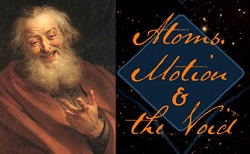 Democritus (painting by Charles-Antoine Coypel) Materialism as a philosophy (or “point-of-view”) seems to have begun during the Axial Age (ca. 800–200 BC) in both ancient India and Greece, which was the dawn of the egoic-mental structure of consciousness.[1] Amazingly, atomists emerged in India around the same time as Buddha, probably with Ajita Kesakambali, Payasi, and Kanada, proponents of the Cārvāka school of Hindu philosophy. Over in Greece, around the same time, the Presocratic (“before Socrates”) philosophers (often called “proto-scientists”) began proposing various “substances” as being the arche (archetype) or fundamental substance of creation. By the 5th-century BCE, philosophers such as Leucippus and Democritus (c. 460–370 BCE) were asserting materialism, in contradiction to Plato's Idealism, with the “Laughing Philosopher,” the “father of modern science” (Democritus) asserting: “Nothing exists but atoms and the void (or empty space); everything else is opinion.” No laughing matter, this materialism business. The word “atom” comes from Greek ἄτομον, atomon, meaning “uncuttable, indivisible,” so everything is seen to be composed of indivisible units (atoms) that combine together to make the larger objects of Nature that we experience with our bodies in space and time. Obviously, Democritus wasn't far from what modern physics proposes today: atoms in empty space (with dark matter) creating our universe far and wide. Now, of course, we know that atoms themselves are divisible into smaller subatomic particles (e.g., electrons, protons, neutrons, quarks, etc., and now, strings). It's important to note these ancient philosophers, by using the power of contemplation and insight, came to these atomic conclusions without advanced mathematics or particle accelerators proving (to a degree) the Eye of Contemplation can indeed make observations and predictions about the structures of the physical world. Today science recognizes atoms and their constituents of negative and positive charges interacting with photons (of no charge) to construct the actual “stuff” of the physical universe, from galaxies and stars to microbes and humans, et al. This materialistic worldview, also known as scientism or scientific materialism, is the dominant view of modern science (and the physicalists at Integral World.net). According to them, even consciousness and all mental activity is nothing but the complex interplay of essential atoms and molecules (outlined in the “Periodic Table”). In any case, the play of atoms in various forms and combinations are “evolving” (or getting more complex) as the expansion of spacetime makes up the universe and us, whether by chance, design, or Spirit-in-action. This grand evolutionary narrative, reconstructed by science, is what Brian Swimme (and others) title: “The Universe Story”[2] or “Big History,”[3] one of the most important discoveries of modern science. According to scientific materialism, the mind and consciousness itself are only by-products or epiphenomena of material processes coming from the biochemistry of the human brain and nervous system. Accordingly, only “physical” material or “stuff” creates and determines consciousness, not vice versa. Seeing with the Eye of Spirit, however, reverses this view because it sees Consciousness as being the fundamental Transcendent-Immanent Source-Condition of all possible universes, realms, thoughts, and beings, thus making it Divine (or Real God). The Eye of Spirit, accessed and integrated by the Integral Vision, doesn't disagree with materialism altogether but rather integrates it into a larger, more accurate worldview that transcends-yet-includes the knowledge of science. As Carl Jung emphasized: “'Physical' is not the only criterion of truth: there are also psychic truths which can neither be explained nor proved nor contested in any physical way.”[4] Consequently, seeing with Integral Vision asserts we live in a psycho (interior) / physical (exterior) existence, not just a gross-physical one, but one involving etheric, psychic, subtle, yogic, and spiritual energies as well, variations on the spectrum of One Divine Energy. Thus, amazingly, we may also ultimately discover that “matter” too is arising as the “Light” or “Energy” of Consciousness Itself. “Matter” as Energy or Light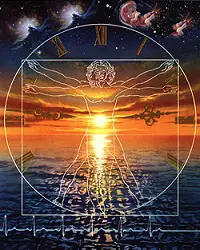 The Search for God (Omni cover, August 1991) “M atter” is not a lump of stuff, a solid particle like our bodies perceive it, though it does have mass and weight in relation to us. Ever since elementary school we've been taught (by science) that we are composed of atoms and empty space; that is, “in reality” we are mostly space, according to science (just like Democritus said). We were taught that if an atom was the size of Yankee Stadium, then the center nucleus would be a grain of salt on the pitcher's mound, while its electrons would be the size of dust orbiting the outer stands;[5] lots and lots of space, in other words, more than solid “things.” And remember, atoms make up every exterior object in the universe. However, obviously, it doesn't seem like matter is mostly empty space to us who have grown up identified with our physical bodies. Everything seems pretty solid, hard as a rock or soft as a feather (and everything in-between), for it's all relative to our individualized body-mind and separate point of view (just like Einstein and the Buddhists say). In fact, if something solid hits us too hard, we get hurt and bleed or drop down dead. That, in fact, matters. To even use the word “matter” or “physicality” or “physicalist” (as Visser-Lane[6] tend to do) is a throwback to nineteenth-century thinking, as if though there has been no significant scientific advancement in the twentieth-century, such as with the profound discoveries initiated by Einstein's relativity theories and the uncertainty of quantum mechanics. Science is indeed the expert (or best authority) in helping us to see (with the Eye of Mind) that things are not as they seem (with the Eye of Flesh), particularly with so-called solid “matter.” This ability to “see beyond” the limits of the five senses is what imparts the marvels and “magical mysteries” (à la Lane) that science offers us. Then once we use this “hidden” knowledge uncovered by science we can manipulate matter (or the “stuff” of atoms and molecules) in new ways to create exciting tools and toys or technologies that fascinate our senses and serve our physical bodies (especially in medicine and relieving manual labor). Therefore, science allows us to know, or certainly believe, it has uncovered some valuable truths. The Integral Vision does not deny this at all (contrary to what Visser-Lane suggest), but fully includes (yet still transcends) the knowledge of the modern scientific method of knowledge acquisition. Again, as integral philosopher Ken Wilber constantly repeats: science is “true but partial” (as are all relative knowledge systems) — the overriding axiom of the Integral Vision.
Advancements in relative knowledge are the great advantage given to us by modern science, yet the Integral Vision maintains science is best used as a valid method of inquiry or technique of knowledge acquisition, not as a Life Philosophy
Advancements in relative knowledge are the great advantage given to us by modern science, yet the Integral Vision maintains science is best used as a valid method of inquiry or technique of knowledge acquisition, not as a Life Philosophy (see Part 1 of “Real Integral vs. Fake Integral”). By integrating-yet-transcending science (i.e., the Eyes of Nature-Body-Mind) — then supplementing them with the knowledge gained by the Transcendent Eye of Soul-Spirit — we gain an even deeper vantage point to our true condition and overall existence. The Eye of Spirit, in other words, knows we are not simply “stuff” (matter-energy), but we are Light, which is Spirit! (just as Jesus said). “Matter” isn't just “magical” or “mysterious” (which it is), as David Lane says, but it is a Miracle, a Divine miracle — or “wondrous work of God.”[7] I do not mean “supernatural” or breaking the “Laws of Nature” (as a miracle is commonly understood), but in its original meaning as an “object of wonder” producing astonishing awe, evidence of the true Divine Nature of our existence. This view also reveals to us unending Love-Bliss and the enlightening insight of wisdom and compassion that includes scientific marvels but offers so much more. By seeing (and knowing) with the Eye of Spirit, we see that light or energy becomes the key to unlocking the secrets of the Kosmos. Even when interpreted with the Eye of Mind (science), yet also made evident with the Eye of Flesh by seeing it as electromagnetic energy, light is fundamental to all holons and processes. In other words, from all views Light interpenetrates everything! This, again, is the miracle of matter! Some people, consequently, see light as being the “Body” or Spirit of God, in religious terms, not just the energy of “matter” or “stuff.” After all, the Bible's Genesis third sentence clearly declares: “And God said: 'Let there be Light!' — and there was light!... and it was good.” Genesis had begun! But that's only a myth, right? Nonetheless, to be clear, this integral view does not absolutize electromagnetic energy, or the photon, or optical light, as being the whole of the Divine. Nor does it elevate the miraculous mystery of the Quantum Vacuum to be the Ultimate Reality, for truly, Real God is neti, neti or “not this, not that,” since it is Unconditional (beyond conditional names and forms). As Wilber long ago warned us in Quantum Questions: Modern physics offers no positive support (let alone proof) for a mystical worldview…. If today's physics supports mysticism, what happens when tomorrow's physics replaces it? Does mysticism also fall?… Genuine mysticism, precisely to the extent that it is genuine, is perfectly capable of offering its own defense [via the Eye of Spirit], its own evidence, its own claims, and its own proofs [via transpersonal validity claims]…. The individuals in this volume [Quantum Questions, a collection of writings from some of the world's greatest physicists] were physicists, but they were also philosophers and mystics, and they couldn't help but muse on how the findings of physics might fit into a larger or overall worldview…. Their aim was to find physics compatible with a larger or mystical worldview—not confirming and not proving but simply not contradicting.[8] 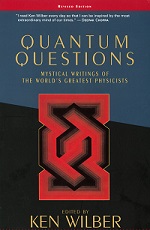
Consequently, I am only acknowledging the inherent unity and compatible relationship already existing between manifested relative light and Absolute Fundamental Light as an Indivisible Oneness or Prior Unity from which the entire relative universe arises and exists. It is “magical,” indeed, it is “wondrous,” it can even be “enchanting,” thus it's often seen as a “mystery,” but mostly certainly it is a Good, True, and Beautiful Divine Miracle! Nothing more; nothing less; but all of that. Light, then, is a sacred matter. Indeed, it's a wonderful testament to the supremacy of Light that it is found in every major spiritual teaching and world religion highly spoken about in their holy texts scattered throughout human history. This is a perennial claim perpetuated by the world's wisest Saints and Sages — as we'll review in “A Brief History Tour of Light” (Part 4 of this series). The Divinity of Light, the Spirit-Light of God is rampant throughout the span of world's Great Wisdom Tradition leading us to see more clearly the veracity of this natural luminous truth, the shine radiating from our loving hearts. In this case, if we take a fully integral approach to understanding what “matter” really is, to see (or know) what the fundamental energy of the universe is actually about, we soon discover it is not just energy but it is light that is Spirit-Energy, literally, in its essence. Light is the workhorse of the Kosmos, interiors and exteriors, “all the way up, all the way down” (as Heraclitus claimed thousands of years ago). In other words, Light is simply “Spirit-in-action” (exactly as Wilber says) Thus, I cannot agree with David Lane's lame conclusion: “We are nowhere near knowing what matter is and what it can portend under different conditions.”[9] Au contraire, I maintain, for we know an awful lot about what matter-energy is, how it arises, and even its connection to Spirit, if seen deeply enough. That is, IF we open all the Eyes of Knowing, activate the Eye of Spirit (via meditation and self-transcendence), transcend our egoic preferences (such as for scientific materialism), and peer more deeply into the soul of Nature which is manifesting as Spirit right before (and as) our very eyes. Then we will know, for sure, we are truly seeing (or knowing) Light as being Real God. The Light is On! Light as Transcending-Yet-Including AQALFrom what I see, Light even transcends-and-includes the “Four Quadrant” model of Ken Wilber's Integral Metatheory, for light is obviously present as the fundamental foundation of all exteriors and interiors (in all quadrants), “all the way up, all the way down” (in all levels). While I realize Wilber's AQAL Theory — “all quadrants, all levels, all lines, all states, all types, etc.” — is his primary (and preferred) way to define “being integral,” yet, for me, it too often appears to create separation and division that can be deluding to seeing reality as a whole. It's certainly very useful to a degree, but only as a map of the territory, not in seeing the territory itself. Yes, as a philosophical (or epistemological) system, it is a beneficial way to ensure we include interiors (or Left-Hand quadrants) with exteriors (or Right-Hand quadrants), the holons so well measured by science. The Integral Approach wants to include all domains of human knowledge acquisition, which is what makes it authentic and an invaluable method for being holistic. Science loves to measure and track individual holons or physical objects (of the Upper-Right quadrant), the exteriors of individual entities (from atoms to molecules to brain stems, et al). It also is fairly adept at measuring the collective systems (or processes) of those exteriors (occurring in the Lower-Right quadrant), since exteriors are the province of its expertise. In fact, through psychology, science has attempted to measure and serve our interiors too, thus providing modes of psychotherapy. However, many of its solutions are exterior-based, such as with drugs and pharmaceuticals. In this case, due to its reductionistic materialism, such exteriors are often all that science cares about, a critique Wilber highlights by calling it “flatland.” Consequently, AQAL Theory insists we must include the interiors of individuals (Upper-Left) and their collective social-cultural systems (Lower-Left), a truly valid approach to being “integral” (as Wilber preaches). However, at times it distorts the wholeness of our living reality (and psyche), a fallacy perpetuated in Wilber's later writing phases (but that is another story). However, we can still use Wilber's theories as a springboard to more profound observations, if we expand our research to include other integral philosophers, and even Spiritual Adepts. Light, since it is the fundamental source-energy of our Universe (as these essays highlight), is obviously active in all quadrants, i.e., as both interiors and exteriors in one spectrum of “Conscious Light” (or consciousness and energy). Light composes and activates the “bodies” or “spheres” (of the gross, subtle, and causal domains) in which exterior forms manifest and interiors of consciousness appear. As electromagnetic energy, light is active in the Right-Hand quadrants, whether as individual holons (Upper-Right) or collective processes (Lower-Right). Light also energizes evolution through the interiors of developmental state-stages in the Left-Hand quadrants (via transcend-and-include). Thus, as Fundamental Divine Light, light is the ground of all interiors and exteriors. Hence, light is the unifying factor of all quadrants, in all levels. This is one of reasons I will not be specifically differentiating the Four Quadrants in these essays. My interest is in the entire AQAL Matrix as a morphogenetic developmental space, not simply mapping interiors-exteriors by following Wilber's method of inquiry. I will leave it to the reader to decide when (and where) to make those important differentiations. Seeing with Integral Vision (or transpersonal vision-logic) is the process of integrating interiors and exteriors as a whole, not creating further fragmentation and complexity. Only then will we initiate a genuine hieros gamos or “sacred marriage” of Western scientific knowledge (the groom) with Eastern esoteric wisdom (the bride). To this Integral Vision we shall set our sights by letting light guide the way. Divine Light: Key to the KosmosTrue Religion is the Esoteric Science (or Luminous Sacred Process) of direct (and directly ego-transcending) investigation of (and enquiry into) Light Itself… True Religion is the Esoteric Science (or True Divine Way) of Truly Knowing (and, thereby, Being) the Unbroken Light. — Avatar Adi Da Samraj (2001) 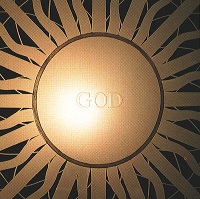 God-Light (painting by Alex Grey) T he Integral Vision attempts to integrate all knowledge claims as a whole (a uni-verse of “one song”) — a genuine “Theory of Everything,” not simply a scientific-mathematical integration or model mapping reality (for “the map is not the territory”). In this essay, I am attempting to summarize my previous essays (“Real Integral vs. Fake Integral, Parts 1-3”), which reviewed the Three Eyes of Knowing, but here I'm also focusing on Light itself. Ultimately, this is seeing with the Eye of Heart, or the nondual mode of knowing, which integrates all the methods of knowing (Flesh, Mind, Spirit). As far as I know, Ken Wilber has never taken this particular approach,[10] but it seems obvious so I will try to shine some light on the subject. A good way to approach this inescapable paradox (and marvelous miracle) of Divine Light is to apply the “two truths doctrine” to differentiate the Transcendent-Immanent domains while maintaining their nondual unity. This is about the only way the Eye of Mind (as philosophy) can hold both views in perspective. “Light” or the Transcendent Divine Spirit-Energy (Shiva-Shakti), which exists as the Kosmos — “Spirit-in-action” (in Wilber's words) — is differentiated below:
The underlying matrix of relative-energy is now known (by science) as the “Quantum Vacuum” or “the Field” — what cosmologist Brian Swimme calls the “All-Nourishing Abyss” — which acts as a generative womb producing the interconnectedness of light and subatomic particles to create and sustain the energy of the universe in a perpetual dance of rhythmic vibrations. This AQAL Matrix (of “all-quadrants, all levels,” etc.) is the interaction of light-energy — or “the patterns that connect” (in Wilber's words) — generating the Kosmos or Cosmic Mandala (from atoms to Atman, so to speak). Science investigates the exteriors forms from the objective perspective of an individual subject, thus often creating a false sense of separation from the whole since it stands apart to measure and observe. However, this is an illusion of the separate self-sense that is transcended in Enlightenment (or God-Realization). Mysticism, on the other hand, investigates the interiors from the subjective perspective of the individual subject, which is difficult for science to measure, but reveals the true structure of Reality once ego-I is transcended. All forms (holons), as Einstein, Heisenberg, et al, as well as the Enlightened Mystics the world over, all agree are relative, that is, interconnected as an ever-changing Matrix of “multidimensional interpenetration with nonequivalence” (in Wilber's words) where each part is dependent (or interdependent) on the whole.[12] 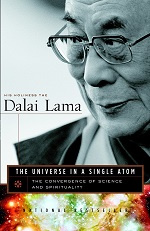
Nevertheless, both “views” are actually one (not-two) or a Nondual Condition that is paradoxically Empty-Full, One-Many, Transcendent-Immanent, etc., which is the Divine Reality (Dharmadhatu) or Divine Person (True Self) that is our Real Condition. Obviously such nondual knowledge acquisition is only gained with the Eye of Spirit, while science (the Eye of Mind) reads or records the exterior correlates and relative measurable manifestations. This spiritual perspective is verified by the like-minded community of the adequately-trained, such as exhibited in the world's Great Wisdom Tradition. Open-minded contemplative meditators, such as the Dalai Lama, for one, see no serious conflict between the discoveries of science and the insights of enlightened Sages, as he explains:
To a Mahayana Buddhist… there is an unmistakable resonance between the notions of emptiness [sunya] and the new physics. If on the quantum level, matter is revealed to be less solid and definable than it appears, then it seems to me that science is coming closer to the Buddhist contemplative insight of emptiness and interdependence.[13] 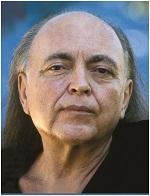 Avatar Adi Da Samraj Avatar Adi Da Samraj, as another mystic, likes to call this nondual reality of “Prior Unity” by the name “Conscious Light” since it is both Consciousness (known via interiors) plus Energy (known via exterior manifest light). This ultimately makes light a spiritual matter, for as the Adept explains: “The transmission of Spirit-Blessing is the transmission of Light. What you taste is light, what you smell is light, what you hear is light, what you see is light, what you feel is light, what you sense altogether is light, the body is light. What is light then? It is nothing but the self-radiant Bliss of the Divine Self.”[14] Know this and be En-Light-ened. Hence the Siddha-Guru expertly (and mystically) continues to summarize the fundamental (and transcendental) nature of Nondual Divine Light: “Matter” Is Conscious Light—not merely ordinary light (which can even change speed, or fly about and be reflected on surfaces, and so on), but Fundamental Light, or the Light That Is Reality Itself. The Conscious Light That Is Reality Itself Is Intrinsically Indivisible, Inherently Unbroken. The conditional [relative] (or space-time) universes are a manifestation of the apparent breaking of Fundamental Light—a curious, simple, apparent “difference” (or division) within Fundamental Light (or Limitless and Non-conditional Conscious Energy, Itself)…. Therefore, the Real Condition (or Reality-Context) of space-time (or the conditional, or cosmic, or psycho-physical, domain) Is Love-Bliss (Itself). Space-time (and even the entirety of all beings, things [holons], or conditions apparent within it) Is… Love-Bliss (Itself).[15]
I am using Adi Da's teaching-words to summarize the Nondual Teachings of the Great Wisdom Tradition, yet in Part 4 — “A Brief History Tour of Light” — I will review this universal approach to the knowledge of Light as it shows up throughout human religious history. All the advanced-tip individuals of humankind, the Shamans, Saints, Sages, and Siddhas, cannot all be wrong. They see this vision by opening the Eye of Spirit to see the real nature of light, which is divine, in order to supplement their daily living and ability to love. From the mystic's view all existence is seen as Spirit-Energy, felt as Love-Bliss, and thus is always already Happy and at peace (beyond qualifications or conditions). We learn to breathe it from the heart radiating to infinity while serving others (and all living beings). Let's listen to Avatar Adi Da go directly to the heart of the matter in his book Real God Is The Indivisible Oneness Of Unbroken Light (2001): “Matter” is not a “lump”. It is not, in and of itself, the defining characteristic (or limit) of “reality”. Truly (and even from the point of view of twentieth-century exoteric-science), “matter” is “energy” (or Light). And “energy” (or Light) Is (In and As Itself) Inherently Indivisible (or One, Only, and Indestructible). Therefore, “matter” is simply a conditional mode of appearance, a merely apparent modification of Inherently Immutable Light!… All of conditionally manifested reality Is Inherently Indivisible Light, or Spirit-Energy, or Hridaya-Shakti, or Love-Bliss.[16] 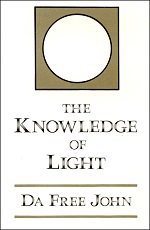
Obviously, from such a truly Nondual En-Light-ened (God-Realized) perspective, the entire universe, the whole Kosmos is not just “matter” or even energy, but is God, is Divine Love-Bliss Itself, is Spirit-Energy, a wondrous Divine Miracle, not simply a “Magical Mystery Tour” of scientific principles (per David Lane's essay). (Though, to rightly honor The Beatles' “Magical Mystery Tour” music and vision, they make humorous and perfect sense: within you, without you!) The world-universe is not, therefore, to be rejected or denied (or considered “dead”), but is to be embraced and participated in as free expressions of Divine Love-Bliss. This is done while always already transcending the limitations of relativity (and a relative universe) by knowing (and communing with) the Transcendental Fundamental Divine Light. As Adi Da makes perfectly clear in his amazing discourse “The Knowledge of Light” (given in 1985; see video below):
There are two fundamental aspects to light: the apparent or objective aspect and the subjective aspect. The objective aspect is what you are seeing as all forms, mind-forms, others, objects, Nature. That, as you know, is light, modified, broken down, refracted, stepped-down, different frequencies of energy over and against other frequencies of energy. So it appears to be rather complex condition, but in reality it is just light itself. If you become involved in consciousness, Consciousness Itself, that to which everything is arising, that which is observing all conditions arising, all objects, others, mind-forms; if you can become profoundly aware just as consciousness itself, that is light. As everything else is light, it is light itself in its subjective mode. It is the Self of light. Light is radiant force and light is consciousness [Conscious Light]. Radiant force is Consciousness Itself; consciousness is self-radiant. But when the radiance of consciousness is modified, as it appears to be in all the forms of Nature or this Cosmic Mandala, then that same self-radiant consciousness takes on an objective form, takes on countless objective forms. Nonetheless, it is still that same light, that same Transcendental Consciousness, Being. When I am talking about light, I mean light. I'm not using a metaphor. When I say “God is Light” I'm not using a metaphor; it is literally so. Of course, light is a great matter then. There is a lot to observe about it, and so on. And you must realize the condition of light yourself.[17]
The Divine, when seen (and known) objectively as energy, and subjectively as consciousness, reveals that Light is the common denominator — hence “Conscious Light” (in Adi Da's words), or as the Buddhists say, “Clear Light Void” (among other traditional terms). Indeed, Ken Wilber too, long ago confirmed when considering the knowledge of modern physics in the pursuit of “quantum questions” that from a mystical perspective: “All things are not ultimately made of subatomic particles; all things, including subatomic particles, are ultimately made of God.”[18] That, my friends, is the Miracle that Matters. The Miracle of Light: Seeing with the Eye of ScienceEnergy is always conserved—It is Indestructible. Energy can be changed, but It cannot be destroyed. Therefore, you (As you Are) cannot be destroyed. You simply cannot. All kinds of transformations are possible, but that is all. — Avatar Adi Da Samraj (2001)[19]
L ight is an enigma. Even to science. In fact, the history of science itself can be traced through its relationship to light and people's questing search to solve its paradoxical puzzles. Light has been one of the greatest mysteries, if not the greatest mystery, known to humankind; it even stumped (or perplexed) perhaps the greatest scientist (and mind) of all time: Albert Einstein. It took science a number of profound revolutions in thinking and understanding to even get close to postulating what light really is. And even now it's still conceded to be mysterious, occupying and interpenetrating all levels of reality (gross, subtle, even causal), for it arises in the Prior Unity of Conscious Light (or Absolute Divine Light). Light as “matter,” in other words, is much more than being “magical” (as Visser-Lane have claimed), but is a Divine Miracle: a Marvelous Wonder of profound depths that not only stimulates the mind but awakens the heart to Love-Bliss Itself, i.e., IF your Eye of Spirit is opened (or opening) to what is really before (and as) you and all of us. 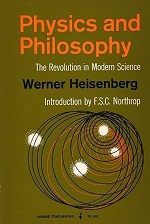
Humanity has awakened to an expanded view of light reaching from the ancient advanced-tip few who saw light as the gaze of God to today's materialistic scientists who see a confounding paradox lying “behind” (or within) the everyday physical world experienced by our five senses.[20] Light is a window that peers into the secrets of the universe (including the realms following death). The ancient Greek natural scientists, from Empedocles (d. 434 BCE) to Plato (d. 348 BCE) and Aristotle (d. 322 BCE), reasoned that light must come out of the eye like a lantern shining from the soul. Hence physicist and author of the dazzling book Catching the Light (1993), Arthur Zajonc, points out: “Our changing view of light is symbolic of a major change in consciousness, an important threshold crossed in the history of the mind.”[21] Nearly two thousand years following the Presocratics, the scientific theories of Sir Isaac Newton (1642-1727) described light as discrete little corpuscles (or particles) splitting into a spectrum, a view countered by the Dutch scientist Christian Huygens (1629-1695) who instead proposed a wave theory of light. In the end, both were right because light is both wave and particle simultaneously. Light has traveled from mythic tales to mystic visions, from geometrical solids to scientific conceptions, each shifting with our evolving worldview and insights into Nature. By the nineteenth century, after democracies had spawned, the era of “electromagnetism” dawned with Michael Faraday (1791–1867) and James Clerk Maxwell (1831–1879) who postulated the field theories basically used by physics today. They used refined experiments in the laboratory buttressed with mathematical equations to initiate a revolutionary view of electricity and magnetism. Maxwell worked out the math to Faraday's experimentally derived theories, yet both were shocked to discover electromagnetism is in fact light (traveling at the same speed). Electromagnetic force or light, therefore, is one of the four fundamental “forces” or Laws of Nature (the others being gravity, the strong and weak nuclear forces). Faraday-Maxwell had set the stage for Einstein and relativity. As one science writer-physicist summarized: Although Galileo had gathered a large amount of data and a few laws exploring motion and free fall, and Kepler had devised empirical laws describing planetary orbits, no synthesis existed putting all the pieces of the puzzle together. Newton not only integrated all the parts into a coherent whole, but also went further, by building a solid conceptual foundation to the sciences of mechanics and gravitation. Maxwell did very much the same with electromagnetism. He put the pieces together into a coherent whole, then went much further. By establishing a solid conceptual foundation to the science of electromagnetism, he unveiled, as an unexpected bonus, the physical nature of light.[22] Electromagnetic radiation is the force powering the universe, from atomic to cosmic levels, from dust to Darwin, from atoms to apes (poetically speaking). Yet, we still find most scientists conceptually trap light in a material medium, as if light behaves like other physical objects; yet it doesn't. Only with some aether-like medium, it was reasoned, can light travel as waves through space, somewhat like sound waves travelling through air. Since electromagnetism appears as a real “thing,” for it does work powering atoms and life — then it must surely exist as an actual material substance (even if a very subtle one). However, this turned out to be inaccurate (as Einstein proved), although at times it certainly appears that way. Light, like we said, is an enigma. By the mid-1800s, Faraday's scientific experiments had forced him to propose that electromagnetic energy was more like waves or “lines of force” or “fields” instead of particles in a material-like substance, à la Newton. Near the end of Faraday's life, as mentioned, Maxwell had developed the math to outline and measure those fields of force. By the end of the nineteenth-century, some physicists even believed the most important laws of physics had been discovered, so all that remained was to fill in the blanks; but the enigma of light shattered that suggestion. A revolution was at hand; a laboratory-driven shift in consciousness was needed because the new discoveries were so difficult for the scientists of the time to logically comprehend since they radically violated common sense and previously held views. Thus the prevailing paradigm was soon shattered. As the twentieth-century dawned, the stage was set for Max Planck (1858–1947) and Albert Einstein (1879–1955) to suggest light behaved more like some weird combination of both waves and particles. In 1901, Planck used the word quanta to mean “quanta of matter and electricity,” then in 1905, in response to Planck's work (and Philipp Lenard's experimental work with quanta of electricity), Professor Einstein suggested radiation existed in spatially localized packets he called “quanta of light” (lichtquanta). That is, electromagnetic radiation is absorbed or emitted in discrete packets, or quanta, throughout the electromagnetic spectrum — from gamma rays to extremely low frequency radio waves to visible optical light somewhere near the middle. Amazingly, Einstein not only proved the existence of atoms (in one of his 1905 papers on Brownian motion), but he also discovered the absolute relativity of light and that matter is really energy. No wonder he is seen as one of the world's greatest geniuses and the most recognized scientist of all time (of course, his wild hair helped). In 1905, with the Special Theory of Relativity (as only one of his five monumental annus mirabilis papers), Einstein turned Newton inside out and upside down, so to speak. The Jewish German genius radically suggested the aether itself was superfluous since there is no absolute meaning to motion. Time distorts with speed and position. Only the speed of light is absolute, as difficult as that is to comprehend. The impact was profound, as one physicist explains: “Light carries with it the secrets of relativity and quantum physics.”[23] This is because everything exists relative to the speed of light, and this fact or “Law of Nature” deeply implicates us (and science) in all our observations, especially at the quantum level. Even now these implications are still penetrating our collective cultural consciousness, a light-initiated paradigm shift.
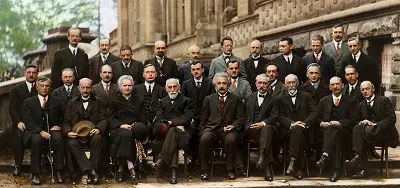
The Fifth Solvay Conference 1927: The Copenhagen Interpretation
“Perhaps the most intelligent picture ever taken.” The paradoxical nature of light at the quantum level was amazingly captured by Niels Bohr's “Complementarity Principle” and Werner Heisenberg's “Uncertainly Principle” giving us the “Copenhagen interpretation” of quantum mechanics, the foundation for today's current Standard Model of particle physics. As hard as it was for these scientists (and us) to grasp, the evidence indicates at its deepest levels Nature is fundamentally uncertain existing in wave-particle dualities, not as solid particles. As Bohr liked to paraphrase psychologist William James: “You can't turn the light on quickly enough to see how the darkness looks.”[24] The twentieth-century had indeed initiated a New Age of thinking: now known as the Atomic Age (especially after the first atom bomb exploded in 1945). 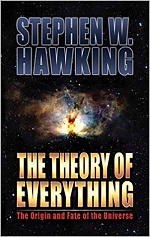
Not surprisingly, Einstein's radical theories were founded upon his investigations into the nature of light, as is commonly known. Light is what he was thinking about as a sixteen-year old boy bicycling down a sunny, country road wondering what it would be like if he was traveling as fast as light. After establishing his General Theory of Relativity of 1915, which integrated gravity with light, Einstein declared, “for the rest of my life I will reflect on what light is!” And indeed he did. Yet, he was never fully satisfied with the final results, since the scientific genius could never unify the smooth theories of general relativity (operating in the large-scale universe) with the jittery quantum mechanics (operating at subatomic levels); so the mystery remains. So far, unfortunately, neither has anyone else captured the right equation. Today this pursuit involves the fabled search for a “Theory of Everything” (TOE) or “Grand Unified Theory” (GUT), a problem even Stephan Hawking (1942–2018) could not overcome. Thus, we can honestly say even the smartest minds in the world, the twentieth century's greatest scientists, nor any of those who have followed, have been able to solve the mysterious enigma of light altogether. Who knows, maybe light is fated to always be a “mystery,” the doorway to Godhead itself? Nonetheless, our understanding of light has improved and expanded greatly over the past hundred years or more. Science currently summarizes: “According to quantum field theory, the universe can be thought of not as isolated particles but continuous fluctuating fields: matter fields whose quanta are fermions (i.e., lepton and quarks), and force fields whose quanta are bosons (e.g., photons and gluons). All these fields have zero-point energy.”[25] In conclusion, light is not composed of actual material particles or subatomic substances, at least not in the form imagined by Newton or strict materialists (such as Democritus). Rather, light is energy itself: electric magnetism, power and charges, sparks and “fire,” real force. Today light is better seen as an interplay between quanta and “virtual particles” (or anti-particles) arising from the so-called “Quantum Vacuum” generating all forms of energy creating all molecular structures, all objects, and all the dynamic processes in the universe, including evolution (see Part 3). Such energy includes, of course, the burning of stars to the dreams of infants, the dance of quarks to the brilliance of quasars, the spark creating atoms to aliens to Avatars. Is this not a miracle? And it all began since spacetime started expanding from the “Big Bang” Beginning to create our reality today and tomorrow, and that of yesteryear (see Part 2). Einstein's En-Light-enment: E = mc2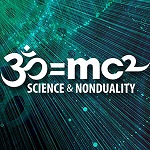 SANDS logo I t was Einstein, of course, who proved there is a deep connection between matter and energy, between light and matter and energy, famously expressed as E = mc2 (energy equals mass times the speed of light squared).[26] This little equation permanently married mass and energy (meaning mass is nothing but bounded energy). It also predicted that no object of mass could go faster than (or as fast as) the speed of light (a speed that can circle the Earth eight times in a second). For any object to travel the speed of light would require an infinite amount of energy, but then its mass too would become infinite, which is impossible. Photons of light, on the other hand, travel at light speeds because they have no mass. This perplexing discovery became known as the Special Theory of Relativity, premiered by Einstein in a 1905 paper titled “On the Electrodynamics of Moving Bodies” (published on September 26). The world's smartest scientist had discovered the speed of light is the same for all observers, regardless of the motion of the light source. Science has never been the same since the Atomic Age dawned for it proved all energy and every holon exists relative to (and in relation to) the speed of light. Although this simple formula addresses the large-scale structure of the universe, this breakthrough discovery helped quantum field mechanics theory uncover how elementary particles interact with each other. Oddly, they exchange energy with so-called “virtual particles,” some type of ghostly energy-packets that seem to come out of nowhere — i.e., they're arising from the Quantum Vacuum or “Void” of “Zero-point energy,” the “All-Nourishing Abyss” (see Part 3). Science writer Timothy Ferris, author of the popular, award-winning Coming of Age in the Milky Way (1988, 2003), explained the practically unexplainable:
The rules governing the brief existence of the virtual particles are set by the uncertainty principle and by the law of conservation of matter and energy. They state that the probable frequency with which virtual particles of a given mass can be produced, and the amount of time each can cavort before falling back into nonexistence, is determined by the energy potential of the vacuum.[27]
By combining and annihilating each other in less than a split instant (10-23 of a second, to be exact), the period of “uncertainty,” these undetectable “particles” cause random fluctuations of energy without any apparent cause.[28] As Richard Feynman famously lamented: “I think I can safely say that nobody understands quantum mechanics.” Obviously, then, my summary too is bound to fail; but proceed we will.
The interaction or play of light-energy with the Void is at the root of all material-physical forms and processes, including those of evolutionary dynamics and “random” mutations.
The interaction or play of light-energy with the Void is at the root of all material-physical forms and processes, including those of evolutionary dynamics and “random” mutations. Consequently, as another physicist-philosopher, Ervin Laszlo, explained, “charged particles such as electrons and quarks are constantly jiggled by the vacuum's zero-point field. If they are at rest, or traveling at constant speeds, the net effect of the jiggling is zero.”[29] As we'll see below, the Quantum Vacuum, as Laszlo continues to explain, “is the most fundamental field of the universe. It 'glues' quarks, stabilizes atoms and solar systems, and creates mass as the force of inertia and gravitation. It connects all things with all other things.”[30] In this case, the basic units of observable nature, the building blocks of everything, from rocks to life, from quarks to brains, finds the mysterious vacuum as both its womb and grave, its all-encompassing source and condition creating what we call “matter.” From our integral perspective, even this quantum display of light and subatomic energy-particles is itself a Marvelous Miracle no matter how you look at it — with either the Eye of Mind or Eye of Spirit — it is a vision that makes even scientists gasp in wonder and ponder its deeper implications. 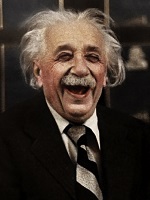 Albert Einstein Einstein's General Theory of Relativity predictions showed that light would “bend” by the force of gravity exerted from large masses, such as with stars or the sun, a prediction proven true by astronomer Sir Arthur Eddington shortly after the First World War. This confirmation made Einstein world famous (as did his personal charisma). Simply stated, Einstein's Special Theory of Relativity (1905) wedded mass and energy (with the formula E = mc2), while his General Theory of Relativity (1915) wove space and time together (as spacetime). Gravity, as a result, is not a separate force, per se, but a consequence of the curvature of spacetime caused by the uneven distribution of mass (such as with planets and stars). So far science has not been able to disprove Einstein's theories, and it has tried hard to do so, thus passing the falsifiablity test. Light, in other words, still remains the only “absolute” in the universe, according to science; the mystic concurs. 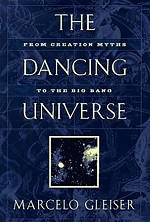
Gravity and electromagnetic light are the two principle forces of Nature exerting an influence beyond the most minute realms of subatomic particles (those other two being the strong and weak nuclear forces) as light races to the farthest reaches of existence as spacetime unfurls. As Professor Gleiser, author of The Dancing Universe (1997), points out: “The fact the electrical and gravitational forces show such a remarkable similarity points to a deep simplicity in the way Nature operates.”[31] What a miraculous paradox and revelatory insight gained with the Eye of Science-Mind pursued by a legion of scientists, but only truly understood with the mystic's Eye of Spirit (in the transcendence of the egoic point of view).[32] However, such “rational mysticism” is also part of the Integral Vision since, as Gleiser explains, “mysticism, if understood as the embodiment of our irresistible attraction to the unknown, plays a fundamental role in the scientific creative process of many physicists, past and present.”[33] Nonetheless, only genuine mysticism as Divine Ignorance (transcending the limits of relative knowledge) realizes the “Emptiness” or Absolute Divinity of all objects in the universe, a view the Integral Vision embraces as well. It is crucial, in other words, that we embrace the Eye of Spirit as well as the scientific Eye of Mind to more accurately see (and know) the whole picture (or story) and our place in it. Once more, the Dalai Lama, as a pure representative of meditative mystics (grounded in practical reality), has no difficulty in acknowledging the breakthrough insights of physics, for as Wilber said earlier: “Physics [is] compatible with a larger or mystical worldview—not confirming and not proving but simply not contradicting [mysticism].” Therefore, real integral thinkers realize the profundity being offered by the master of physics himself, Albert Einstein, as His Holiness explains: In a nutshell, Einstein's special theory of relativity implies that, while the speed of light is invariable, there is no absolute, privileged frame of reference, and everything, including space and time, is ultimately relative. This is a truly remarkable revelation.[34] This is because, from the Buddhist perspective (and mysticism in general), they recognize the principle of “Dependent Origination” where all things and beings (or holons) are totally interdependent and interrelated with all other holons. Thus everything only exists relative to one another, as just one part always already connected to the whole (hence holons are “whole/parts”). This has vast ethical (and political) implications, for it indicates we must take good care of each other (and all of Nature) with love and compassion, as the Sages teach, for we are intimately related with everything and everyone.[35] This is made possible, in large part, by the interactions of light since it connects everything to everything else while acting as the engine or powerhouse of the universe's evolutionary processes generating our “scientific” Creation Story and even our spiritual development. 
This insight of energy-matter-light equivalency, gained from the Eye of Mind, is so profound, for example, that it prompted Siddha-Guru Adi Da Samraj to boldly propose: “Christ = mc2,”[36] thus suggesting: “The formula E = mc2 and the [scientific] theories of 'relativity' are the expressions of the intuition that the universe is an awesome paradox (not a cause-and-effect simplicity), and that the present conditions [of the universe], as well as the ultimate Condition of the apparent universe (analyzed by our senses), are never more than partially revealed to the lower-adapted conventional mentality of unevolved [humankind].”[37] Light, in other words, arising from the Quantum Void is not only non-corporeal as it manifests forms and objects and living beings, but is also spiritual or arising from and as Spirit-in-action (as Wilber is fond of saying). Or as the Buddhist Heart Sutra puts it: “Form is Emptiness, Emptiness is form.” As another example, the popular organization investigating “science and nonduality” (called SANDS) has a logo of ॐ = mc2 (i.e., OM = mc2). Therefore, as mentioned, the Integral Vision maintains we always need to integrate the Eye of Science with the Eye of Spirit in order to see Reality as It truly IS, as well as how it operates and functions. This is how we thereby transcend the relative and materialistic knowledge of science to see the Absolute Truth of our sacred existence as being the play of Divine Light, the Divine Domain arising here and now, not simply stuff or plain ol' matter.  NOTES[1] See: Ken Wilber, Up from Eden (1981); Jean Gebser, The Ever-Present Origin (1949, 1985); Karl Jaspers, The Origin and Goal of History (1953, 1976); Karen Armstrong, The Great Transformation: The Beginning of Our Religious Traditions (2006). [2] See: Brian Swimme, The Universe Story: From the Primordial Flaring Forth to the Ecozoic Era - A Celebration of the Unfolding of the Cosmos (1992, 1994) [3] See: David Christian, Origin Story: A Big History of Everything (2018, 2019); Big History:Between Nothing and Everything (2013); Maps of Time: An Introduction to Big History (2004); Cynthia Stokes Brown, Big History: From the Big Bang to the Present (2012). [4] C.G. Jung, Answer to Job (1958, 1973), p. xi. [5] See: Gary Zukav, The Dancing Wu Li Masters: An Overview of the New Physics (1979, 2009). [6] Frank Visser (founder) and David Christopher Lane (main contributor) at integralworld.net. [7] “Miracle” from mid-12th-century, "a wondrous work of God," from Old French miracle (11c.), from Latin miraculum "object of wonder" (in Church Latin, "marvelous event caused by God"), from mirari "to wonder at, marvel, be astonished," from mirus "wonderful, astonishing, amazing," earlier *smeiros, from PIE *smei- "to smile, laugh" (source also of Sanskrit smerah "smiling," Greek meidan "to smile." [8] Ken Wilber, Quantum Questions: Mystical Writings of the World’s Greatest Physicists (1984), pp. ix-x, 26. [9] See: David Lane, “The Magical Mystery Tour of Matter: It Is Never ‘Just’ Stuff” (on integralworld.net) [10] See: Ken Wilber, Quantum Questions (1984, 2001). [11] See: Werner Heisenberg, Physics and Philosophy (1958), p. 63. [12] See: Ken Wilber, Quantum Questions: Mystical Writings of the World's Great Physicists (1984, 2001), and Eye to Eye: The Quest for the New Paradigm (1984, 2001). [13] His Holiness the Dalai Lama, The Universe In a Single Atom: The Convergence of Science and Spirituality (2005), p. 50. [14] Adi Da Samraj, from the discourse “The Knowledge of Light” given on February 3, 1985 [15] Adi Da Samraj, “Indivisible Perfect Space” Essay in The Aletheon (2009), pp. 1766-1767. Avatar Adi Da’s unique use of capitalization is meant to convey a new sense of the English language in order to better represent His Enlightened View, therefore, I will respectfully (and rightly) retain His Original presentations; sometimes we must temper our reactivity to that which is unconventional in order to see more deeply into reality than the ordinary visions of the conventional ego-I. [16] Adi Da Samraj, Real God Is The Indivisible Oneness Of Unbroken Light (2001), p. 156, 158. [17] Adi Da Samraj [Da Free John], from the discourse “The Knowledge of Light” given on February 3, 1985 [18] Ken Wilber, Eye to Eye (1983, 1990), p. 167. [19] Adi Da Samraj, “Space-Time Is Love-Bliss” in Real God Is the Indivisible Oneness of Unbroken Light (2001), p. 223. [20] See: Physics and Philosophy (1958, Harper Torchbooks, NYC) by Werner Heisenberg, one of the best books I've ever seen reviewing the ancient Greek roots of atomic science. [21] Arthur Zajonc, Catching the Light: The Entwined History of Light and Mind (1993), p. 24. [22] Marcelo Gleiser, The Dancing Universe (1997), p. 181. [23] Marcelo Gleiser, The Dancing Universe (1997), p. 238. [24] Quoted in The Dancing Universe (1997) by Marcelo Gleiser, p. 235 [25] Wikipedia, “Zero-point energy” entry [emphasis added]. . [26] See: E=mc2: A Biography of the World's Most Famous Equation (2001) by David Bodanis [27] Timothy Ferris, Coming of Age in the Milky Way (1988), p. 352. [28] See: Lynne McTaggart, The Field (2002), p. 19. [29] Ervin Laszlo, Science and the Reenchantment of the Cosmos (2006), p. 28. [30] Ervin Laszlo, Science and the Reenchantment of the Cosmos (2006), p. 30 [italic added]. [31] Marcelo Gleiser, The Dancing Universe (1997), p. 174 [caps added]. [32] See: Ken Wilber, Quantum Questions: Mystical Writings of the World’s Greatest Physicists (1984, 2001). [33] Marcelo Gleiser, The Dancing Universe (1997), p. 4 [italics in original]. [34] His Holiness the Dalai Lama, The Universe In a Single Atom: The Convergence of Science and Spirituality (2005), p. 60. [35] See: Robert Thurman, Inner Revolution: Life, Liberty, and the Pursuit of Real Happiness (1998). [36] See: Adi Da Samraj [Da Free John], "Christ=mc2" in Scientific Proof of the Existence of God Will Soon Be Announced by the White House (1980), p. 269ff; p. 275: "'E = mc2' actually and exactly means the same thing to us today, to our nervous systems, to the individual body-mind or being, that 'Christ is risen from the dead' meant 2000 years ago. 'E = mc2' is exactly what 'Christ is risen from the dead' means. E = mc2 is good news! It proclaims that matter is energy—that the body-mind of every human being can be Realized to be energy, or light." [37] Adi Da Samraj [Da Free John], "Christ=mc2" in Scientific Proof of the Existence of God Will Soon Be Announced by the White House (1980), p. 273.
|